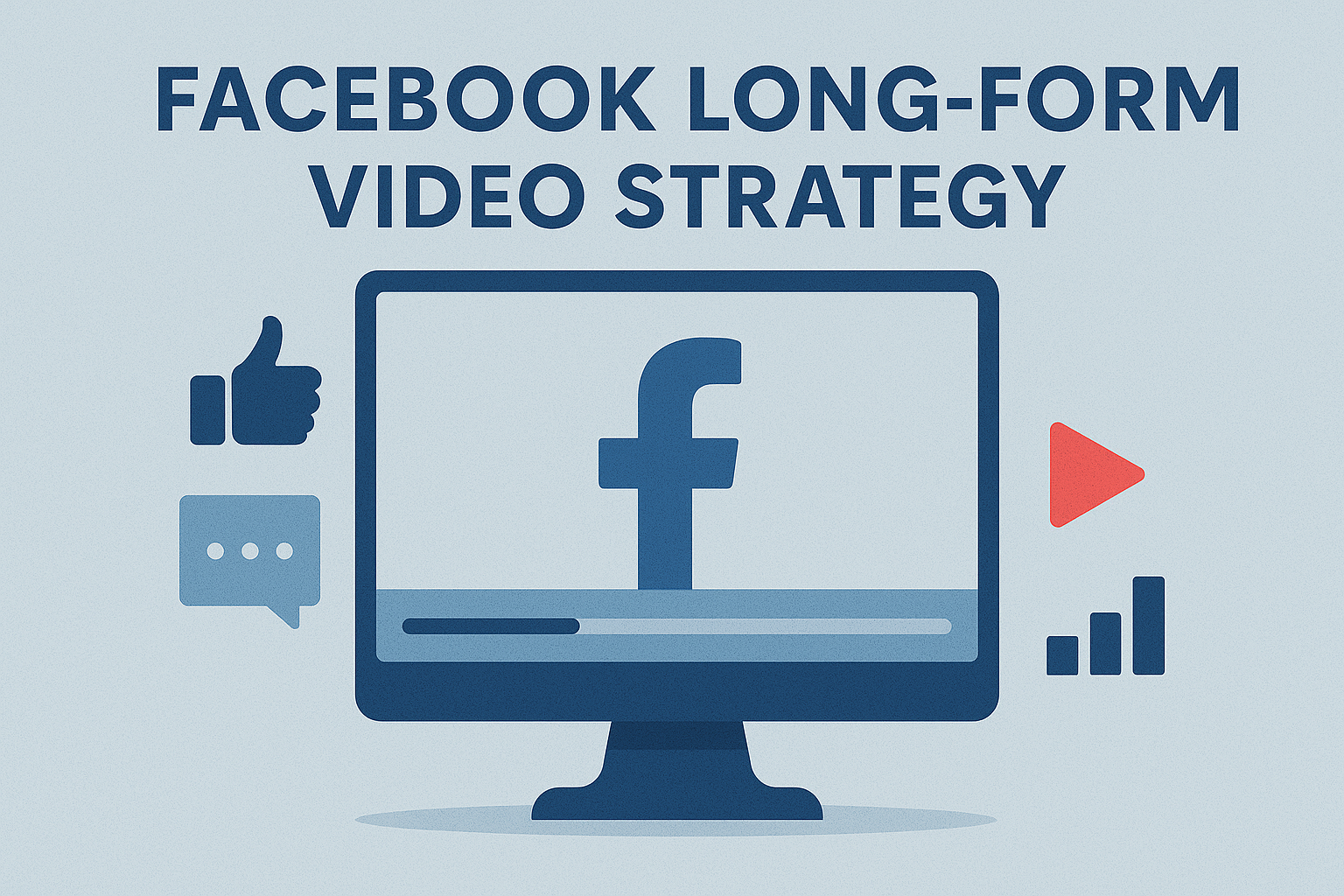
June 2025 Facebook Algorithm: What You Need to Know
23 June 2025
Facebook Long-Form Video Strategy 2025: Optimal Length & Engagement
26 June 2025The Ultimate Guide to Facebook Reels and Long-Form Videos in 2025
Facebook’s Focus on Video in 2025
: It’s no secret that video content reigns supreme on Facebook today. With the platform garnering over 8 billion video views daily, Meta’s latest algorithm updates have doubled down on video-first, “native” content.
Short-form clips (Reels) and native feed videos are being prioritized in users’ feeds, meaning savvy marketers must optimize both formats to maximize reach.
In this comprehensive guide, we’ll explore Facebook video optimization strategies for 2025 – from creating thumb-stopping Reels and engaging longer videos, to technical specs, captions, engagement hacks, and paid ad tactics. Let’s dive in and get your Facebook video content primed for peak performance!
Optimizing Facebook Reels (Short-Form Video)
Facebook Reels (vertical videos up to 90 seconds, similar to Instagram Reels) are currently some of the most viral content on the platform. Meta is “doubling down on Reels” as a content format, with Reels-style ads outperforming traditional formats by 20–30% in engagement. To ride this wave, follow these best practices for Facebook Reels:
Create Native, Engaging Vertical Videos
Facebook’s algorithm heavily favors original, high-quality Reels.
Always upload video files directly to Facebook rather than sharing YouTube or external links – native Facebook videos earn 478% more shares than external video posts.
Film in vertical (9:16) aspect ratio to fill the mobile screen, and take advantage of Facebook’s built-in creative tools (text overlays, stickers, filters, music tracks) to make your Reel feel native to the platform.
Using trending audio or effects can also give your Reel a boost in discovery, as the algorithm considers “trending elements” a positive signal for wider reach.
Above all, focus on originality and quality – Facebook explicitly limits reach for low-effort, recycled content (e.g. TikTok watermarks or blurry footage).
What to avoid:
Facebook’s official recommendations say to avoid low-quality Reels – for example, don’t post videos that are blurry, pixelated, or have another app’s watermark (like a TikTok logo), and don’t use horizontal or bordered videos in Reels.
Such content looks inauthentic and will be down-ranked by the Reels algorithm. Stick to crisp, full-screen vertical clips that showcase original content.
Hook Viewers in Seconds and Tell a Story
To succeed with Reels, grab attention within the first 1–3 seconds. As with any feed video, people scroll fast – you need a hook right at the start (a bold visual, an intriguing question or scene) to make them stop.
Aim to “capture the viewer’s attention within the first three seconds – that’s how you stop the scroll”.
Consider opening with your most compelling shot or a punchy headline text on the video. Immediately convey what the video is about or why it’s exciting.
For example, demonstrate a dramatic “before vs after” in the first moments or pose a quick question that the video will answer.
Even within a 30 or 60-second Reel, storytelling matters. Try to structure your short video with a beginning, middle, and end – e.g. introduce a challenge or question, show the process, then deliver a payoff. This narrative arc gives viewers a reason to watch till the end, maximizing your completion rate (a key metric – Reels that people watch to completion get favored by the algorithm).
Authenticity and storytelling is king on social video; as Facebook advises, “create entertaining content that has a clear hook… authentic storytelling is more likely to perform well.”
So even in short-form, focus on relatable, human moments or interesting stories rather than pure sales pitch.
Optimize Reel Length: 60–90 Seconds is the Sweet Spot
Don’t assume ultra-short is always best. While Reels can be as short as a few seconds, data shows that slightly longer Reels (closer to the 90-second max) actually drive higher engagement.
In a 2024 study, Reels in the 60–90 second range had the highest average engagement rate, outperforming 15 or 30-second clips. Why? Even in a fast-paced format, audiences appreciate a bit of context or payoff that very short clips often lack.
Longer Reels have more room to develop a narrative or deliver value, which leads to more likes, comments, and shares.
Data from Socialinsider (2024) showing that Facebook Reels approaching the 90-second limit achieve the highest engagement rates. Longer Reels give more time to tell a story or deliver a payoff, resulting in modest but meaningful boosts in interaction.
That said, make every second count – don’t stretch a Reel longer than necessary. If you can deliver your message in 45 seconds, do it.
But if you have a great 90-second idea, go for it and use the full time (Facebook allows up to 90s for Reels).
The key is to maintain interest throughout: use quick cuts, lively music, captions, and dynamic visuals to avoid drop-off. Watch your retention graph in Insights; if you see big drop-offs, tighten your content. The goal is to have viewers watch the entire Reel and ideally re-watch or seek more – this signals the algorithm to show it to more people.
Pro tip:
- End your Reel with a subtle call-to-action or teaser for more.
- For example, some creators prompt viewers to “watch again to catch all the tips” or “follow for Part 2.” This can drive engagement and repeat views.
- Just avoid blatant engagement-bait phrases (which Facebook discourages, such as “Like this video and share now!”). Keep it organic and related to the content.
Optimizing Native Facebook Video Posts (Longer Videos & Feed Posts)
- In addition to Reels, Facebook continues to support longer-form videos posted to your Page or profile feed.
- These might be 1-5 minute how-tos, vlogs, interviews, etc., that appear in followers’ feeds or on your page timeline.
- Optimizing these native videos (uploaded directly to Facebook) is crucial for organic reach and watch time.
- In The next Section I will tell you how to make your standard video posts perform their best:
Ideal Video Length and Storytelling Strategy
- Finding the right video length is a balancing act – you want your content to be long enough to deliver value and keep people watching, but not so long that viewers lose interest.
- For 2025, data suggests that around 2–4 minutes is an optimal length for Facebook feed videos, with ~3 minutes being a “sweet spot.” One recent analysis found that videos about 3 minutes long achieved the highest engagement rates on average (higher than 1-minute or 5-minute videos).
- At the same time, these longer videos generated far more comments and shares than short clips, presumably because they provide more substance that prompts discussion and sharing.
- Facebook itself has indicated that its algorithm gives extra weight to videos over 3 minutes if they hold viewer attention beyond the first minute – rewarding “loyalty and intent” (people intentionally watching your content) and “view duration.” In fact, “Facebook’s algorithm likes videos over three minutes long that hold viewers’ attention for at least one minute.”
What does this mean for you?
- Don’t be afraid to make a 3+ minute video if you have a compelling story or informative piece – as long as it’s engaging. Use that time to delve into a narrative, provide detailed tips, or evoke emotion.
- For example, a case study or customer story might naturally run 3-4 minutes; that depth can spur more shares and comments than a 30-second teaser.
- Storytelling techniques are key: hook the viewer early (in the first 5–10 seconds) by previewing the value or outcome, build interest with a logical flow, and deliver a satisfying conclusion or call-to-action.
- Keep the pacing tight (edit out fluff, use cuts or graphics to maintain energy). Essentially, earn the viewer’s time – if you do, Facebook will likely amplify your video to more people due to strong retention.
Note That:
On the other hand, short videos (30–60 seconds) aren’t dead either – they often get higher completion rates and are great for quick announcements or simple demos.
Shorter clips can perform very well for top-of-funnel content or quick social promos.
Just note that they might not generate as many comments or shares compared to slightly longer content that really resonates.
A good strategy is to mix it up: use bite-sized videos for easy consumption, but also incorporate a few longer pieces where it makes sense (e.g. a 3-minute mini-webinar or behind-the-scenes story) to drive deeper engagement.
Data from Socialinsider (2024) showing
- average Facebook engagement rate by video length. Videos longer than 3 minutes see a slight uptick in engagement and significantly more comments/shares compared to shorter clips, suggesting that viewers reward content with substance.
Bottom line:
The best length is “as short as possible, but as long as necessary.”
If you can hook your audience and keep them watching, longer videos can pay off in reach and sharing.
Always monitor your video metrics (audience retention graphs, drop-off points, etc.) to fine-tune your ideal length.







